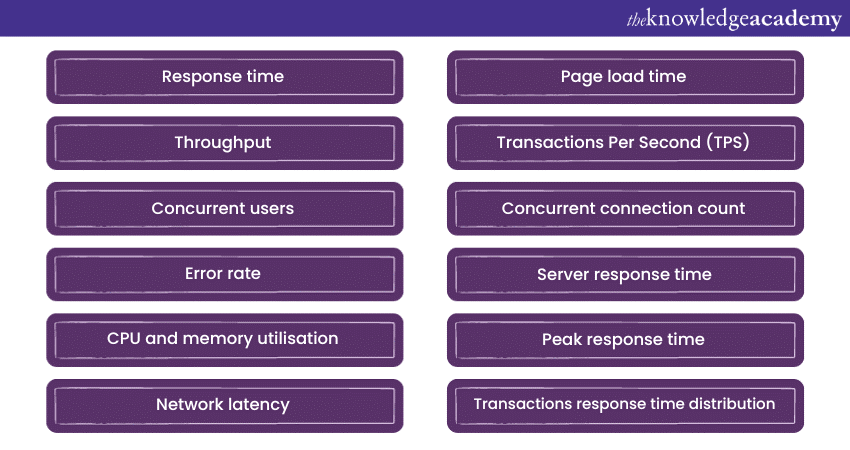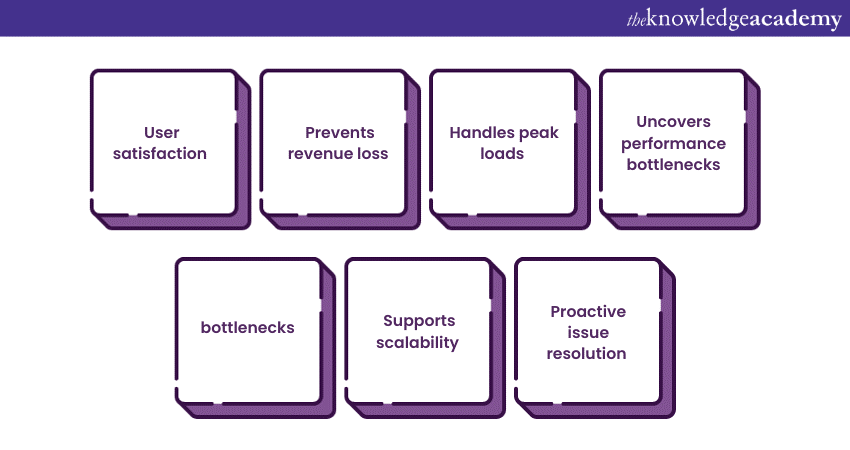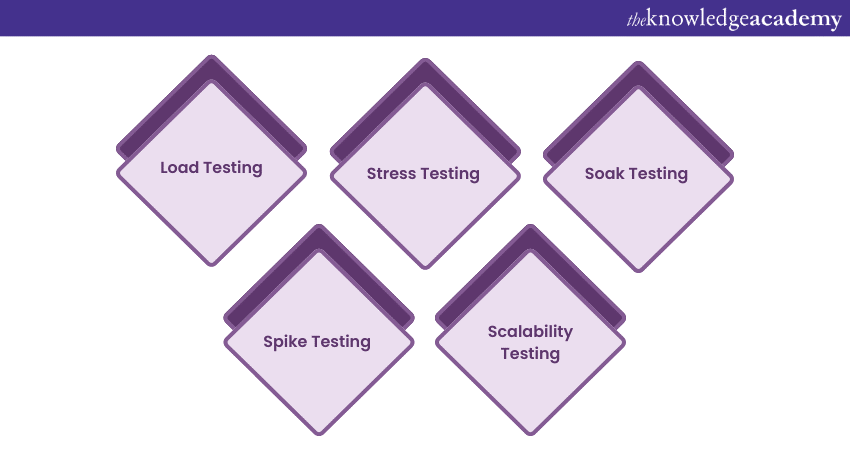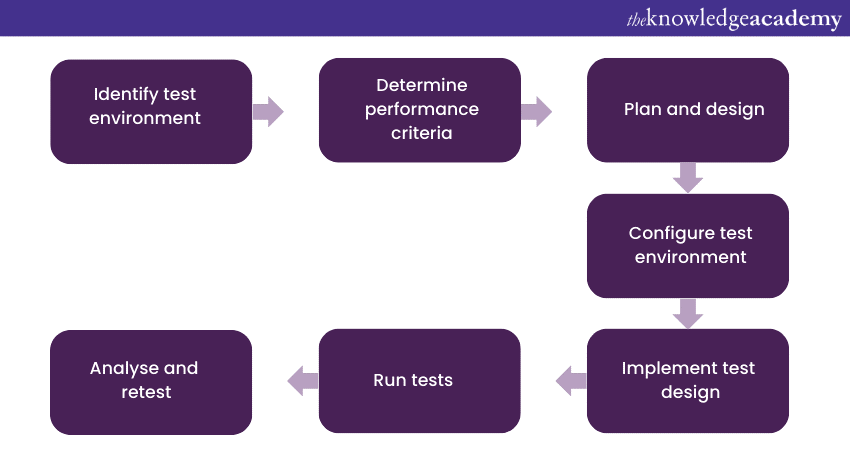We may not have the course you’re looking for. If you enquire or give us a call on 01344203999 and speak to our training experts, we may still be able to help with your training requirements.
Training Outcomes Within Your Budget!
We ensure quality, budget-alignment, and timely delivery by our expert instructors.

Performance Testing is a crucial component of Software Testing that ensures your application can handle the expected load, stress, and performance levels under various conditions. Performance Testing in Software Testing aims to ensure that the software meets specific performance criteria and provides an optimal user experience across different usage scenarios.
However, it's not just about identifying problems; it's also about validating that the software meets or exceeds performance expectations. But what exactly is Performance Testing in Software Testing? This comprehensive blog covers the key concepts, types, processes and benefits associated with Performance Testing in Software Testing.
Table of Contents
1) What is Performance Testing in Software Testing?
2) Understanding Performance Testing metrics
3) Why use Performance Testing?
4) Types of Performance Testing
5) Performance Testing process
6) Conclusion
What is Performance Testing in Software Testing?
Performance Testing is a crucial part of Software Testing that evaluates the responsiveness, stability, speed, scalability, and overall reliability of a software application under various conditions. It involves subjecting the application to a range of scenarios that simulate real-world user interactions, load levels, and system stresses. By conducting Performance Testing, you can identify performance bottlenecks, weaknesses, and potential issues before they impact end-users.
Advance your testing skills with our Web Application Performance Testing with JMeter Training - Join now!
Understanding Performance Testing metrics
Performance Testing metrics are quantifiable measurements that provide insights into various aspects of an application's performance. These metrics help assess how well the application is performing, identify bottlenecks, measure resource utilisation, and determine whether the application meets performance goals. Here are key Performance Testing metrics:

1) Response time: Measures the time for the application to respond to a user action, directly affecting user experience.
2) Throughput: Indicates the number of transactions the application can handle, reflecting its capacity.
3) Concurrent users: Measures simultaneous users accessing the app, identifying capacity limits.
4) Error rate: Tracks errors like crashes and timeouts, highlighting performance issues.
5) CPU and memory utilisation: Monitors efficient resource usage and detects memory leaks.
6) Network latency: Measures data travel time, affecting web performance.
7) Page load time: Measures the time to load a web page, impacting user engagement.
8) Transactions Per Second (TPS): Measures overall transaction handling.
9) Concurrent connection count: Monitors simultaneous connections, assessing scalability.
10) Server response time: Focuses on backend processing time.
11) Peak response time: Identifies worst-case response time.
12) Transaction response time distribution: Shows response time variations across transactions.
Performance Testing
Performance Testing is not just a recommended practice; it's a crucial step in the software development process that offers a wide range of benefits. Let's delve deeper into why Performance Testing is essential and how it contributes to the overall success of software applications.

Ensuring user satisfaction
In the digital age, user expectations for application performance are higher than ever. Slow-loading pages and unresponsive applications can frustrate users and drive them away. Software Performance Testing ensures that your application provides a seamless and enjoyable user experience by verifying that it responds quickly to user interactions, leading to higher user satisfaction and retention.
Preventing revenue loss
Downtime and poor performance can have a direct impact on your bottom line. Whether you're running an e-commerce platform, a financial application, or a gaming platform, downtime can result in lost sales, missed opportunities, and dissatisfied customers. Performance Testing helps identify and rectify potential performance issues before they lead to revenue losses, safeguarding your business's financial health.
Handling peak loads
Many applications experience fluctuations in user activity due to various factors such as promotions, events, or seasonal demand. Software Performance Testing allows you to assess how your application handles peak loads. By simulating heavy user traffic during such periods, you can make sure that your application remains stable, responsive, and available, even when the user load is at its highest.
Meeting business objectives
Successful software applications align with business goals. Performance Testing ensures that your application can support the intended user base and workload. It helps you determine whether your application's performance aligns with your business objectives, whether it's handling a specific number of concurrent users, processing transactions efficiently, or delivering content promptly.
Uncovering performance bottlenecks
Performance bottlenecks can lurk within your application's architecture, code, or infrastructure. These bottlenecks might not surface during normal usage or functional testing. Performance Software Testing brings them to light by stressing the system under varying conditions. Identifying and addressing these bottlenecks early on prevents unexpected slowdowns or crashes in production environments.
Supporting scalability
Software applications need to accommodate growth. Whether your user base is expected to grow steadily or experience sudden spikes, Performance Testing ensures that your application can scale seamlessly. By testing scalability, you can plan for infrastructure upgrades or optimisations in advance, ensuring that your application can handle increased demand.
Proactive issue resolution
Performance Testing is about more than just identifying problems—it's about preventing them. Detecting and addressing performance issues during the testing phase saves time, money, and resources that would be otherwise spent on resolving these issues in a live environment. This proactive approach leads to smoother launches and fewer surprises post-deployment.
Elevate your career as a Certified Software Testing Professional (CSTP) - Register in our Certified Software Testing Professional (CSTP) Training now!
Types of Performance Testing
Performance Testing encompasses various methodologies that focus on assessing different aspects of a software application's performance. Let's delve into the different types of Performance Testing and understand their objectives, methods, and significance.

Load Testing
Load Testing involves evaluating how a system performs under an expected load. The objective is to determine whether the application can handle the anticipated user load without any performance degradation or system failures. Load Testing helps identify performance bottlenecks, response times, and resource utilisation under different load levels.
Load Testing simulates concurrent user activity by creating virtual users who interact with the application simultaneously. The load is gradually increased to observe how the system behaves under different load conditions.
Significance: Load Testing ensures that the application can sustain the expected user load, helping prevent slowdowns or crashes during peak usage periods.
Stress Testing
Stress Testing takes performance evaluation a step further by assessing the application's behaviour under extreme conditions beyond its specified capacity. The goal is to identify the breaking point, understand the system's failure modes, and observe its recovery process.
Stress Testing usually pushes the application to its limits by increasing the load until it starts exhibiting performance degradation or crashes. This helps in determining the system's maximum capacity and its ability to handle unexpected situations.
Significance: Stress Testing helps uncover vulnerabilities, assess the system's robustness, and formulate disaster recovery plans.
Soak Testing
Soak Testing, also known as endurance testing, involves subjecting the application to a sustained load over an extended period to identify performance issues that might not surface during shorter tests. The objective is to discover memory leaks, resource leaks, and performance degradation over time. Soak Testing involves running the application with a constant load for an extended duration, often 24 to 72 hours, while monitoring its performance metrics and resource utilisation.
Significance: Soak Testing helps identify issues that might only emerge after prolonged usage, ensuring application stability over time.
Spike Testing
Spike Testing examines how the application handles sudden and significant increases in user load. The goal is to assess whether the system can quickly scale up to accommodate the spike in traffic without crashing. This type of Testing involves rapidly increasing the load to simulate a sudden surge in user activity and then observing how the system responds and stabilises.
Significance: Spike Testing helps evaluate the system's ability to handle abrupt changes in user demand and validates its scalability.
Scalability Testing
Scalability Testing assesses the application's ability to scale up or down based on varying user loads and resource requirements. The goal is to ensure that the application's performance remains consistent as the user load increases or decreases. Scalability testing involves gradually increasing the load to assess how the application scales. It can also include testing scenarios with different hardware configurations.
Significance: Scalability Testing is essential to ensure that the application can accommodate future growth without compromising performance.
Enhance your testing skills with our expert-led Software Testing Courses. Register now!
Performance Testing process
The Performance Testing process involves a series of well-defined steps to ensure that a software application can withstand the expected load, deliver optimal performance, and provide an excellent user experience. Let's break down the process into its key stages and understand the significance of each step:

1) Requirement analysis
Before beginning any Performance Testing, it's crucial to understand the application's requirements, user expectations, and performance goals. This stage involves collaborating with stakeholders, developers, and business analysts to gather information about the application's expected load, response times, and user behaviour.
2) Test planning
Test planning involves creating a comprehensive strategy for conducting Performance Testing. This includes defining the test objectives, selecting the appropriate Performance Testing types (load, stress, etc.), outlining the testing environment, specifying the hardware and software configurations, and establishing success criteria.
3) Test environment setup
Setting up the test environment involves replicating the production environment as closely as possible. This includes configuring servers, databases, network settings, and other components required for testing. The environment should mimic the real-world conditions in which the application will be deployed.
4) Test scenario design
Test scenario design involves creating scripts that simulate user interactions with the application. These scripts define the actions, navigation paths, and data inputs that users would typically perform while using the application. Test scenarios should be representative of different user personas and usage patterns.
5) Test execution
During test execution, the prepared test scenarios are executed against the application. The system's performance metrics, such as response times, throughput, and resource utilisation, are monitored and recorded. This phase involves generating load, stress, or other testing conditions as specified in the test plan.
6) Monitoring and analysis
Continuous monitoring of the application's performance metrics is essential during test execution. The testing team analyses the collected data to identify performance bottlenecks, resource utilisation patterns, and areas of concern. This phase involves closely observing the application's behaviour under different conditions.
7) Reporting
After completing the test execution and analysis, a detailed performance test report is generated. This report includes information about the test environment, executed scenarios, observed performance metrics, identified issues, and recommendations for improvements. The report proves to be a valuable resource for stakeholders and developers.

Conclusion
Throughout this blog, we've explored the essential concepts of Performance Testing in Software Testing, its types, the benefits it offers, and the steps involved in the testing process. In a world where user expectations for fast and reliable software are higher than ever, Performance Testing plays a crucial role in ensuring your application's stability, responsiveness, and overall quality.
Unlock your career potential with ISTQB Software Testing Foundation Training - Sign up now!
Frequently Asked Questions
Upcoming Business Analysis Resources Batches & Dates
Date
 Software Testing Automation Course
Software Testing Automation Course
Thu 5th Sep 2024
Thu 12th Dec 2024
Thu 9th Jan 2025
Thu 3rd Apr 2025
Thu 31st Jul 2025
Thu 6th Nov 2025







 Top Rated Course
Top Rated Course


 If you wish to make any changes to your course, please
If you wish to make any changes to your course, please


